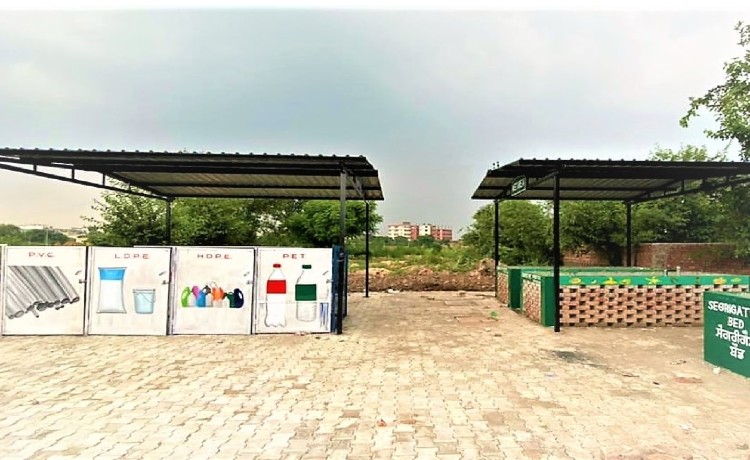The success of the Swacch Bharat Mission Gramin Phase 1, has played a crucial role in increasing sanitation facilities at household level across the country and many studies have attributed to a positive impact on community health especially women and children resulting in improvement in health indicators like child mortality rate and for that, there is a lot to celebrate. However rural India still has a long way to go to transform its solid and liquid waste management systems in order to achieve targets surrounding the sustainable development goals, and to bring to life Mahatma Gandhi’s vision of ‘total sanitation for all.’
To support that, Swacch Bharat Mission Gramin phase 2 was launched in 2019 which aims to ensure the sustainability of open defecation-free behaviours, and shift the focus to address the issue of solid and liquid waste management in India.
The Current State of Waste Management in Rural India
So why waste management is so important in rural India and what are the impacts of the problem?
Currently, rural India lacks the systems to effectively and efficiently handle both solid and liquid waste, with a number of associated costs to the environment, health, the economy and overall community wellbeing.
In rural areas, solid waste includes waste from kitchens, cattle sheds, agriculture, and materials such as metal, paper, plastic and cloth. Though most of the solid waste generated in rural areas is organic and degradable, it is becoming a major problem as the waste is not segregated and, according to the Ministry of Drinking Water and Sanitation, equates to approximately 0.3 to 0.4 million metric tonnes per day.
Additionally, when water is used once and is no longer fit for human consumption, it becomes liquid waste, which can be either industrial or domestic in nature. Most rural areas in the country let domestic run-offs of greywater collect in open areas and drains, or flow into local water bodies – putting communities at risk by creating an environment for the breeding of diseases and pathogens. Rural India on average generates about 31,000 Million litres of greywater on a daily basis.
And with rapid population growth, an increase in consumerism and intensified commercial activity, the problem is only going to get worse. The load of liquid waste alone is set to increase significantly in rural areas as the Jal Jivan Mission is well on its way to achieving its goal of ensuring potable drinking water at each household level through a functional tap connection. This alone will result in increased greywater load in rural areas, which need to be treated and handled well.
Systems Required to Prevent Disease & Harness Waste as a Resource
The Swacch Bharat Mission Phase 2 is encouraging and supporting panchayats to plan interventions for both solid and liquid waste management in their respective villages - creating the necessary infrastructure to empower communities to better manage their waste.
With work already started across many villages there is good progress being made. And with the proper treatment systems in place, not only can communities prevent the negative health and environmental impacts of waste, but both solid and liquid waste can be harnessed as a crucial resource for rural communities.
Composting of animal, farm, and kitchen solid waste is a very old practice that need to be used effectively as compost is a very important resource for soil health on which livelihoods of a large section of communities depend. Plastics can be collected, segregated and shredded for use in other purposes. Waste paper, cloth, metal and glass can all be recycled.
Untreated greywater if managed safely and scientifically, has the potential to be used in kitchen gardens, for non-potable domestic use like washing and cleaning, and for irrigation purpose.

From ‘Individual’ to ‘Community’ Behaviour Change
But whilst each community needs to adopt waste management systems that are suitable to their local needs, a transformation in behaviour change is required if SBMG Phase 2 is to be successful.
Whilst the focus of Phase 1 was on building toilets at each household level and changing individual behaviors to ensure people used them, Phase 2’s success will depend on ‘collective responsibility' as entire communities need to make changes in managing their solid and liquid waste.
Therefore, strong behaviour change communication is required to support the effort.
In Conclusion
Mahatma Gandhi once said ‘Sanitation is more important than independence.’ He made cleanliness and sanitation an integral part of the Gandhian way of living. And when you consider that just 5 short years ago, 300,000 children in India under the age of five years died every year from diarrheal diseases due to poor sanitation, he was right.
Improved sanitation is the key to reducing the mortality and morbidity burden of diarrhoea in India, but it goes far above and beyond mere toilet construction. Whilst this has been the focus at a household level to date, there is a need to urgently take the next step and address the vast solid and liquid waste management issues of India, at a community level.
Work is well underway and there are many success stories where community members are adopting new norms and systems around solid and liquid waste management in their villages – helping to spread awareness and increase the pace of this important work across the country.
As such, there is great hope for the future.
Sources


.png)
.jpg)



0 Comment